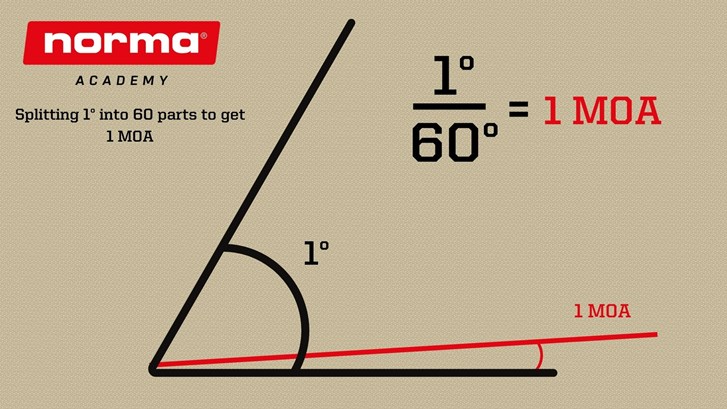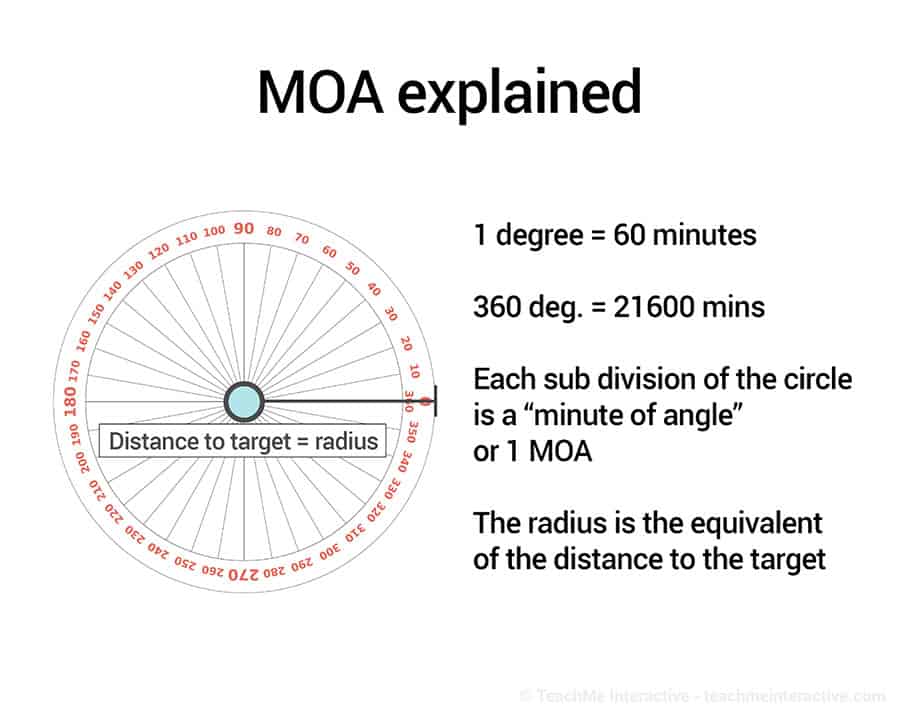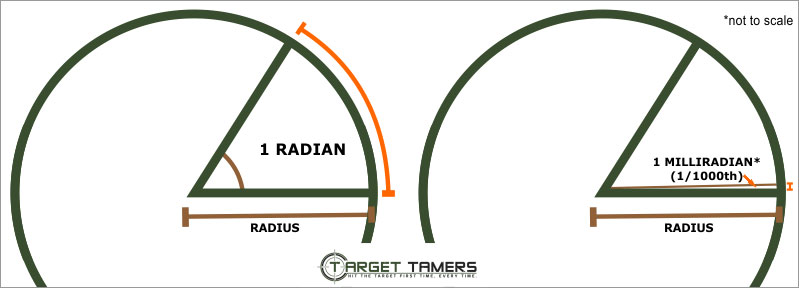
Finding the perfect rifle scope for your weapon is just as important as the rifle itself. That’s where it can get a little bit confusing. While you’re searching, you start hearing all these terms like MOA scope or MRAD scope, MOA conversion, so on and so on. Now you’re confused and still need to find the optic that’s right for you. So, what does all this mean? How do you navigate it all and pick what’s right for you?
If you ask some of your more experienced fellow shooters, they’ll most likely know exactly what you’re talking about. In the world of rifle scopes, MOA and MRAD are the most important units of angle measurement when it comes to sighting your scope reticle. Just because they both measure angles doesn’t mean they are anything alike. So let’s break it down some more.
Why Does It Matter?
Well, for functional reasons, both are equally as good. It mostly just comes down to what system you want to use and how it works in your mind. It’s kind of like the metric vs. imperial system debate. It all comes down to which one you’re more used to using, or that makes more sense to you.
What is MOA?

MOA stands for minute of angle. This is a form of an angular measurement. One minute of angle is equal to about 1 inch of deviation from the point of aim on a target for every 100 yards. It carries on for further distances like so: 2 inches for 200 yards, 3 inches for 300 yards, etc. These numbers aren’t exact but are only approximations. The exact numbers are decimals.
This system is based around minutes and degrees. An MOA measurement is used to calculate the target’s distance and the MOA turret projection of where the bullet will land.
How Does It Work?

Let’s take a closer look at the math. Since this system is centered around minutes and angles, a circle is what is used to convey the angular measurement. There are 360 degrees to one circle. There are 60 minutes to 1 degree. So there are 21,000 minutes in one circle.
For a better way of understanding it, think of it like this. You are standing 100 yards away from a target. There is a circle that is around you and you are standing directly in the center of it. If you look at the target, the center of it is directly on the outer edge of the circle and is a straight line in front of you.
Now divide that circle into 360 parts, for each degree in the circle. Now, if you were to measure the distance that stands between each divider line at the edge of the circle, the amount would equal 62.83 inches. So, 1 degree is 62.83 inches. It’s often just rounded to 60 for simplicity reasons.
Knowing this, finding your own MOA isn’t that hard. Just take the distance of your target in yards, multiply it by 1.047, and divide that number by 100. That will leave you with your very own MOA angular measurement. If you’re not a math whiz, you can just look up an MOA conversion chart. There’s tons of them on Google alone, so you shouldn’t have any issues when you’re trying to sight your new scope.
This system isn’t perfect though. Since most conversion charts round the 1.047 value to 1, that can leave you with a percentage of inaccuracy. If you’re just shooting from less than 100 yards, the 1 to 100 ratio is completely fine. It’s when you start long range shooting that things start to get hairy. Once you get into longer distances, there becomes up to a 5% margin of error when you’re shooting, which adds up quickly when you’re looking for an accurate scope reticle.
MOA Scope Adjustment

Most MOA scopes will adjust off a pretty basic measurement when it comes to your MOA adjustment. The MOA reticle will often be adjustable to 0.25 inches for 100 yards, 0.50 inches at 200 yards, etc. The full values are listed below.
MOA Scope Adjustment Increments
| MOA Deviations | MOA Scope Adjustment Increments |
| 100 yards = 1.0 inch | 100 yards = 0.25 inch |
| 200 yards = 2.0 inch | 200 yards = 0.50 inch |
| 300 yards = 3.0 inch | 300 yards = 0.75 inch |
| 400 yards = 4.0 inch | 400 yards = 1.00 inch |
| 500 yards = 5.0 inch | 500 yards = 1.25 inch |
| 600 yards = 6.0 inch | 600 yards = 1.50 inch |
| 700 yards = 7.0 inch | 700 yards = 1.75 inch |
| 800 yards = 8.0 inch | 800 yards = 2.00 inch |
| 900 yards = 9.0 inch | 900 yards = 2.25 inch |
| 1000 yards = 10.0 inch | 1000 yards = 2.50 inch |
This table is only showcasing the approximations of the values. There is a table of true MOA values that we will discuss later. For now, let’s just focus on the concept.
It’s time to put this into a real scenario example. Let’s say that your particular rifle scope has a windage error of 2.5 inches to the right when shooting from 500 yards. Windage is just the amount that your scope can be moved from left to right. In order to compensate for this error, you’d have to adjust your windage turret to to the left by 2 adjustments. Since one increment is 0.25, this means you’ll be adjusting 0.50 inches. This is because the MOA is 5.00 inches for 500 yards.
It might sound a little confusing now, but once you get your hands on a scope and read a little further, you’ll see what I mean. For the most precision in the shooting world, a lot of gun enthusiasts use the true values of MOA in order to calculate their margins. Typically, most hobby shooters will just use the rounded versions of MOA. Here’s a table of the true values of MOA adjustments.
MOA True Scope Adjustment Increments
| MOA Deviations | True MOA Scope Adjustment Increments |
| 100 yards = 1.047 inch | 100 yards = 0.2617 inch |
| 200 yards = 2.094 inch | 200 yards = 0.5235 inch |
| 300 yards = 3.141 inch | 300 yards = 0.7852 inch |
| 400 yards = 4.188 inch | 400 yards = 1.0470 inch |
| 500 yards = 5.236 inch | 500 yards = 1.3088 inch |
| 600 yards = 6.282 inch | 600 yards = 1.5705 inch |
| 700 yards = 7.329inch | 700 yards = 1.8323 inch |
| 800 yards = 8.376 inch | 800 yards = 2.0940 inch |
| 900 yards = 9.423 inch | 900 yards = 2.3558 inch |
| 1000 yards = 10.47 inch | 1000 yards = 2.6175 inch |
If you’re a die-hard aimer, let’s dive into some more detailed examples with these new values.
Let’s say you’re shooting a rifle that is sighted properly for a 200 yard distant target. You’re aiming to shoot a target that’s at a range of 400 yards away. With that long range, the bullet drop would equate to 23 inches.
Bullet drop is just another variable that will affect where you will land your shots. It’s pretty basic physics: the further away you shoot from, the lower the bullet impact will hit the target if you are aiming at the center. So, in order to compensate, you would have to aim higher to hit the center of the target. We’ve all had experience with the concept of bullet drop at some point in our lives. Whether that was just throwing a ball and missing the target, or even through video games.
Back to the scenario. Along with the bullet drop, you are shooting north. There’s a breeze coming from the east at 10 miles per hour. In order to compensate for the bullet drop, you would have to utilize the turret adjustments. You would have to raise the elevation adjustment by 22 increments. Based on some other math that doesn’t really pertain to this topic, you would have to adjust the windage turret by 11 increments to the right to counter the wind. The windage increments will depend on the bullet and rifle type itself. The total change in this scenario would come out to be about 3 MOA.
What is MRAD?

MRAD is another form of angular measurement. What’s different from MOA? Well, here, radians (rad) are used instead of minutes. Radians are a more recognized unit of measuring degrees, especially in mathematics. You might recognize it from high school math problems.
How Does It Work?

A single radian is 57.3 degrees. Instead of 21,000 minutes to a circle, now we are talking 6.2832 radians per circle. Even further, there’s 1,000 milliradians, or mils, in each radian. So, there’s 6,283.2 milliradians in a circle.
Remember the whole imperial vs. metric system debate? Well, this particular measurement system was actually derived from the metric system. So, if you’re not a meters guy, you might want to stay away from this style of angular measure. But seriously, there’s no actual difference between MOA and MRAD. The only actual difference is the units. MRAD, or mil, is like centimeters and MOA is like inches. Inches and centimeters have no technical differences except the unit of measure.
MRAD Scope Adjustment

Just like the MOA system, MRAD uses distance as part of the calculation. MRAD scopes will most likely use increments of 0.10 mils to adjust the windage and elevation adjustments. Even a full single mil will end up making a pretty noticeable difference when shooting, so the increments are much smaller.
The value of 0.1 mils is seen as 1 centimeter for every 100 meters, 2 for 200, 3 for 300, you get it by now. Unlike MOA, the milliradian MRAD system works with whole numbers, which can make sight your mil reticle a much simpler process than using a bunch of MOA decimals.
As an example, if your bullet drop is 33 cm when your range is 300 meters, your elevation adjustment would have to be moved up 11 times. If you have a windage error of 3 cm to the left at 100 meters, all you have to do is adjust your windage 3 increments to the right. Simple, right?
MRAD Scope Adjustment Increments
| MRAD Deviations | MRAD Scope Adjustment Increments |
| 100 meters = 10 cm | 100 meters = 1.0 cm |
| 200 meters = 20 cm | 200 meters = 2.0 cm |
| 300 meters = 30 cm | 300 meters = 3.0 cm |
| 400 meters = 40 cm | 400 meters = 4.0 cm |
| 500 meters = 50 cm | 500 meters = 5.0 cm |
| 600 meters = 60 cm | 600 meters = 6.0 cm |
| 700 meters = 70 cm | 700 meters = 7.0 cm |
| 800 meters = 80 cm | 800 meters = 8.0 cm |
| 900 meters = 90 cm | 900 meters = 9.0 cm |
| 1000 meters = 100 cm | 1000 meters = 10.0 cm |
These numbers are much easier to work with.
For example, you’re shooting a weapon that is properly sighted for a 100 meter range. Your target is 300 meters away. The bullet drop comes out to be 42 centimeters. Your elevation adjustment would have to be raised to 14 increments. Each 0.10 of a mil would equal 3 cm at 300 meters.
Now, let’s talk windage. You’re doing some long range shooting at 500 meters. But your bullet impact is a little too much to the right, and is hitting 5 cm offset. You’ll have to adjust the windage turret and move it 1 increment to the left. At this distance, a tenth of a mil is equal to 5 cm.
The equations come out significantly cleaner when using the MRAD adjustment system. So, let’s talk some pros and cons of each to help you decide which is best for you.
MOA vs. MRAD: What’s Better?
As I’ve said quite a few times already, neither system proves any functionality over the other. It’s like comparing inches to centimeters. There’s no real comparison here, just the simple fact that they are two different ways of taking an angular measure. There’s some things to consider about each system before making your final decision.
MOA System Key Features
We went over the MOA system in tons of detail today, but let’s summarize the main points:
- The MOA system adjustment increments are a finer adjustment.
- If you’re more familiar with imperial measurements like inches, this system will feel familiar.
- Most ballistic lists use yards like MOA.
If you’re an avid hunter and are used to using MOA, great! Keep using it. If you’re familiar with the system, it’s a great way to accurately zero in your weapon and land a great shot. If you’re a metric system user, you might want to take a look into MRAD if you’re not already acquainted with MOA. It will suit your situation better.
MRAD System Key Features
Let’s take the main points from today’s MRAD discussion:
- The numbers equate easier and in whole numbers, making the whole process simpler.
- More experienced shooters and high-end equipment brands use MRAD.
- It’s standardized for many defense forces, including the US military.
Of course, if you’re used to using the metric system, it would just make more sense to use MRAD. This system gives clean numbers and easy to understand results because of the way it works.
MOA and MRAD Overlap

You have to pay attention to what you’re buying though. A lot of products and brands will use both systems in one product. For example, rifle scopes might have a mil reticle but use a turret adjustment system in minutes. So, whichever one you choose, you should make sure you have at least a basic understanding of the opposite. They often interconnect in important situations. Although the MRAD might seem easier to use because of its whole numbers, most ballistic measurements are in imperial, which will require some conversion if you use MRAD.
Tips
With all that said, there’s plenty of information here to help you out in which system to use. It’s all based on personal preference. Just go with your gut and choose the one that’s right for you. Neither will outperform the other, since there is no real difference between the two.
Besides that, there’s some other things you should keep in mind when adjusting your scope, no matter the system you choose, and using your new optic.
Use a Single System
First off, make sure all your gear uses the same system. It’s either all MOA or all MRAD. When you start mix and matching, that’s where you can get confused. With confusion will come inaccurate results and disappoint. So, take care to buy matching products when you can.
Sighting Correctly
With everything that you learned today, there should be no excuse for you to end up with a poorly sighted rifle. Take your time and apply your new knowledge. With patience, practice, and technique you’ll have an accurate weapon in no time. Just make sure you follow the steps that apply to the system you are using. Whether that’s MOA or MRAD, both have separate directions for use.
Practice Makes Perfect
Even with your new scope sighting system, it’s still important to practice and test every sight you do. MRAD and MOA will mean nothing if you don’t fire a few shots to see where you’re landing. Doing so will also help you practice your zeroing skills for the future. Don’t give up if you don’t nail it the first try. There’s a lot of information here to take it and it will take time to become an expert.
Seek out a professional gun handler and fellow shooters for their help if you are struggling.
Short Summary
| MOA Key Features | MRAD Key Features |
| Allows for finer adjustments. | Is simpler due to using whole numbers. |
| Is based on the imperial measuring system (inches, feet, yards). | Is based on the metric measuring system (centimeters, meters). |
| Better if you are familiar with the imperial system. | Better if you are familiar with the metric system. |
| Most ballistic charts utilize the MOA system. | Most high end equipment/brands use MRAD. |
| Uses degrees and minutes. | Uses radians and milliradians. |
| Is more common amongst shooters. | Is standardized for many militaries. |
References

Mike Hardesty is a published freelance gun writer. He also possesses specialized expertise in rifle scopes With dozens of articles and reviews published in Pew Pew Tactical, Snipercountry.com, and TTAG (The Truth About Guns), Mike is considered a firearms expert. His special area of expertise is handguns.
Mike is a long-time shooter. He has been punching paper targets, taking deer and other game and shooting at competitions since about 1975. Other related pursuits include reloading and bullet casting. He currently reloads for over 10 calibers, both handgun and rifle. His reloads, particularly for 9mm, were in great demand during the height of the ammo shortage among family and friends. He donated hundreds of rounds to informal shooting sessions. He was quoted as saying “I do not sell my reloads but I sure will help my guys shoot ’em for free!”. He has a few cherished firearms that he has inherited or otherwise procured — those are his favorites.
He earned B.S. and M.S. degrees from Indiana State University in 1974-1975.
He’s a firearm experts and is the founder of mhardesty.com.
